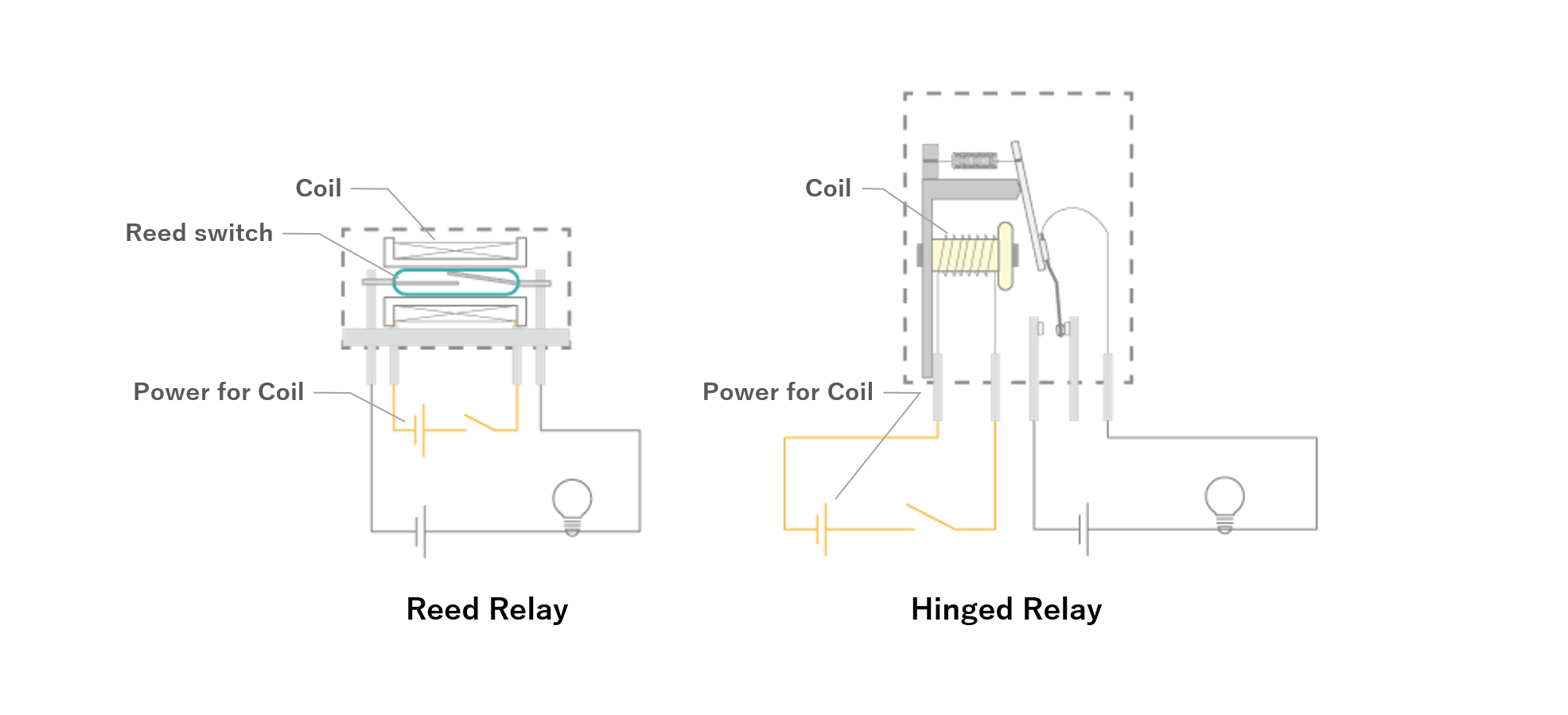Relays
What is a Relay?
A relay is an electronic component that turns a circuit (contact point) ON or OFF (circuit switching) by inputting or outputting an electrical signal.
Relays are used in a wide range of equipment and machines that are controlled by electrical signals, from familiar products such as home appliances to industrial products and control panels.
There is also a wide variety of relays, and relays suitable for various applications are used in a wide range of situations.
Relays are used in a wide range of equipment and machines that are controlled by electrical signals, from familiar products such as home appliances to industrial products and control panels.
There is also a wide variety of relays, and relays suitable for various applications are used in a wide range of situations.

Definition of electromagnetic relay
In general, an electromagnetic relay is a relay that turns electricity on and off by inputting and outputting electricity to and from a coil, which opens and closes its contact points due to the electromagnetic force generated in the coil. They are also called "electromagnetic relays" or "mechanical relays.
Among them, small electromagnetic relays for control are defined as "hinged and reed type electromagnetic relays for use in electric circuits with an AC or DC frequency of 50 Hz or 60 Hz, a voltage of 250 V or less, and a current of 30 A or less". (See JIS C 5442 (corresponding international standard: IEC 255-7))
The electromagnetic relays we handle are reed type electromagnetic relays that employ the Yaskawa Power Reed Switch (Bestact), which has our original structure.
Among them, small electromagnetic relays for control are defined as "hinged and reed type electromagnetic relays for use in electric circuits with an AC or DC frequency of 50 Hz or 60 Hz, a voltage of 250 V or less, and a current of 30 A or less". (See JIS C 5442 (corresponding international standard: IEC 255-7))
The electromagnetic relays we handle are reed type electromagnetic relays that employ the Yaskawa Power Reed Switch (Bestact), which has our original structure.
Reed and hinged relays
Both "reed relays" and "hinged relays" use the electromagnetic force of the coil to drive the contacts, but the principle and structure are different. The reed relay uses a reed switch as the contact mechanism, and the reed switch contact is turned on and off by the magnetic force of the coil. The "hinged relay" uses a hinge mechanism for the contact mechanism, and the magnetic force of the coil causes the contact to rotate around the hinge to turn the contact on and off.

Features of Reed Relays
The main features of reed type relays are described below.
➀ The contact part is sealed in a glass tube, making the contact mechanism less susceptible to external influences such as dust and organic gas (silicone gas).
(2) Inert gas is sealed in the glass capillary to prevent oxidation of the contacts.
As a result of the above, the reed type relay has excellent durability and reliability.
The main features of reed type relays are described below.
➀ The contact part is sealed in a glass tube, making the contact mechanism less susceptible to external influences such as dust and organic gas (silicone gas).
(2) Inert gas is sealed in the glass capillary to prevent oxidation of the contacts.
As a result of the above, the reed type relay has excellent durability and reliability.
Types of reed relays
Reed relays are broadly classified into PCB mounting relays and plug-in relays.
PCB mounting relays
PCB mounting relays are relays with terminals shaped for mounting on printed circuit boards. They are characterized by their small size, relatively low power consumption, and high operating speed.
PCB mounting relays
PCB mounting relays are relays with terminals shaped for mounting on printed circuit boards. They are characterized by their small size, relatively low power consumption, and high operating speed.
Plug-in Relays
A plug-in relay is a relay mounted by inserting the relay terminals into a dedicated socket. The socket is secured to a DIN rail or similar surface, making it easy to replace the relay. One feature of this type of relay is that the relay itself can be easily replaced, and depending on the socket, wiring can also be easily changed.
A plug-in relay is a relay mounted by inserting the relay terminals into a dedicated socket. The socket is secured to a DIN rail or similar surface, making it easy to replace the relay. One feature of this type of relay is that the relay itself can be easily replaced, and depending on the socket, wiring can also be easily changed.
How to relect a relay
Key factors in the selection process include rated operating current/voltage, electrical life (durability), power consumption, drive power supply, and ambient operating temperature.
Rated operating voltage/current refers to the voltage and current values to be used under specified conditions (on/off, switching frequency, and electrical switching durability). Please check the voltage and current values of the circuit in which you actually want to turn the contacts on and off, and how many V or A they will be. Here we introduce the contact performance of the aforementioned reed switch (Bestact).
The electrical life (durability) is a rough estimate of how long a relay can open and close depending on the voltage/current and load (resistive or inductive load) applied to the contacts. It is used as a guideline when considering how much load and how many times the relay will be used in the circuit under consideration.
The rated current rating is the current value that can continuously energize the contact switch without opening or closing the contact (when the circuit is closed) and without exceeding the temperature rise limit of each part. Please confirm the magnitude of the current that can be supplied to the contact open/close area.
The drive power supply is the input power supply to the relay coil. Since there are direct current (DC) and alternating current (AC) power supplies, please confirm which type is used.
Coil voltage refers to the voltage applied to the coil required to turn the contacts ON and OFF. The relay can be operated accurately by applying the specified coil voltage.
Power consumption is a numerical value obtained by multiplying the voltage/current when the relay coil is energized for a certain period of time. Please make sure that the power consumption does not exceed the specified value. The formula is as follows Voltage (V) x Current (A) = Power consumption (W) (in the case of direct current)
Ambient operating temperature refers to the temperature of the ambient environment where the relay is actually used. When selecting a relay, please confirm that it is within the range of the ambient operating temperature.
The time required from the time the relay coil is energized to the time the contacts are turned ON/OFF. Please confirm that there is no problem in your circuit after considering the time it takes from input to output.
Rated operating voltage/current refers to the voltage and current values to be used under specified conditions (on/off, switching frequency, and electrical switching durability). Please check the voltage and current values of the circuit in which you actually want to turn the contacts on and off, and how many V or A they will be. Here we introduce the contact performance of the aforementioned reed switch (Bestact).
| Bestact type | R25 | R15 | remarks | |
| Rated operating current | AC | 220V 0.5A | 220V 1A | induced load(50/60Hz) |
| DC | 110V 0.3A | 110V 0.5A , 220V 0.2A | induced load(R25:L/R=40ms R15:L/R=100ms) | |
The electrical life (durability) is a rough estimate of how long a relay can open and close depending on the voltage/current and load (resistive or inductive load) applied to the contacts. It is used as a guideline when considering how much load and how many times the relay will be used in the circuit under consideration.
The rated current rating is the current value that can continuously energize the contact switch without opening or closing the contact (when the circuit is closed) and without exceeding the temperature rise limit of each part. Please confirm the magnitude of the current that can be supplied to the contact open/close area.
The drive power supply is the input power supply to the relay coil. Since there are direct current (DC) and alternating current (AC) power supplies, please confirm which type is used.
Coil voltage refers to the voltage applied to the coil required to turn the contacts ON and OFF. The relay can be operated accurately by applying the specified coil voltage.
Power consumption is a numerical value obtained by multiplying the voltage/current when the relay coil is energized for a certain period of time. Please make sure that the power consumption does not exceed the specified value. The formula is as follows Voltage (V) x Current (A) = Power consumption (W) (in the case of direct current)
Ambient operating temperature refers to the temperature of the ambient environment where the relay is actually used. When selecting a relay, please confirm that it is within the range of the ambient operating temperature.
The time required from the time the relay coil is energized to the time the contacts are turned ON/OFF. Please confirm that there is no problem in your circuit after considering the time it takes from input to output.











